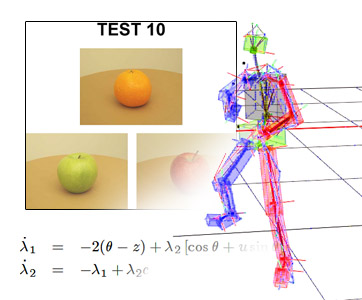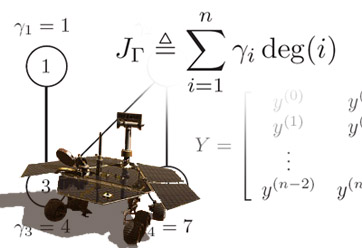Research
Coordination via Distributed Infrastructure
When multi-robot systems are deployed in developed areas, static infrastructure, like wireless routers, cell phone base stations, or air traffic control towers will typically be used for communication between the agents. Can it also be used for control?
Taking inspiration from fluid dynamics and algebraic topology, we develop algorithms in which control authority is split between mobile agents and a network of static infrastructure nodes. Computations are distributed throughout the static network, which arrives at global decisions about how agents are allowed to flow throughout an environment.
In this approach, agents
- project specified flows onto global constraints – like incompressibility, irrotationality, and their higher-dimensional analogues;
- construct hybrid controllers that achieve these flows in the continuous space; and
- distribute all computations over the static network, making only local decisions.
Dynamic Similarity Measures

What does it mean when people say that two motions are "similar?" This is an important question in the area of human-robot interactions, where robots must interpret human movements in order to act in an equivalent manner. Alternatively, suppose we would like a puppet to do "the same thing" as a human. The puppet has different degrees of freedom, different dimensions, and different dynamics from the human: What is the appropriate way to compare puppet motions to human ones, or to control the puppet so it does "the same thing?" This work addresses these questions from two different directions:
- by directly measuring the preferences of human judges.
In this approach, the idea is that when people compare alternatives, they are implicitly making reference to an objective function "inside their heads;" the goal, then, is to reverse-engineer this objective function based on peoples' expressed preferences.
- by using similarity measures based on homeomorphisms.
In this second approach, we "warp" one motion in time and space so that it resembles another motion, and use the amount of warping as our measure of dissimilarity.
Networked Health Monitoring

One of the main motivating forces behind the rapidly emerging theory of decentralized, cooperative control is the idea that we can deploy large collections of agents – like robots, sensor "motes," or aerial vehicles – over wide spatial domains to solve otherwise intractable surveillance and monitoring problems. However, it is inevitable that in such networks, the performance will deteriorate over time as resources, such as battery power, are depleted. To analyze this, we introduce the notion of health; the idea is that healthy agents – like robots with full batteries and no mechanical problems – are able to react more quickly to changes in their environment than unhealthy ones. This work addresses questions like:
- How do the healths of individual agents impact the behavior of the network as a whole?
- What can be determined indirectly about the healths of individual agents, by observing the way they behave in the network?
- Are there reasonable metrics for the "overall health" of a network, and how can they be measured in a distributed fashion?
![kingston [at] gatech [dot] edu](img/email_w.png)